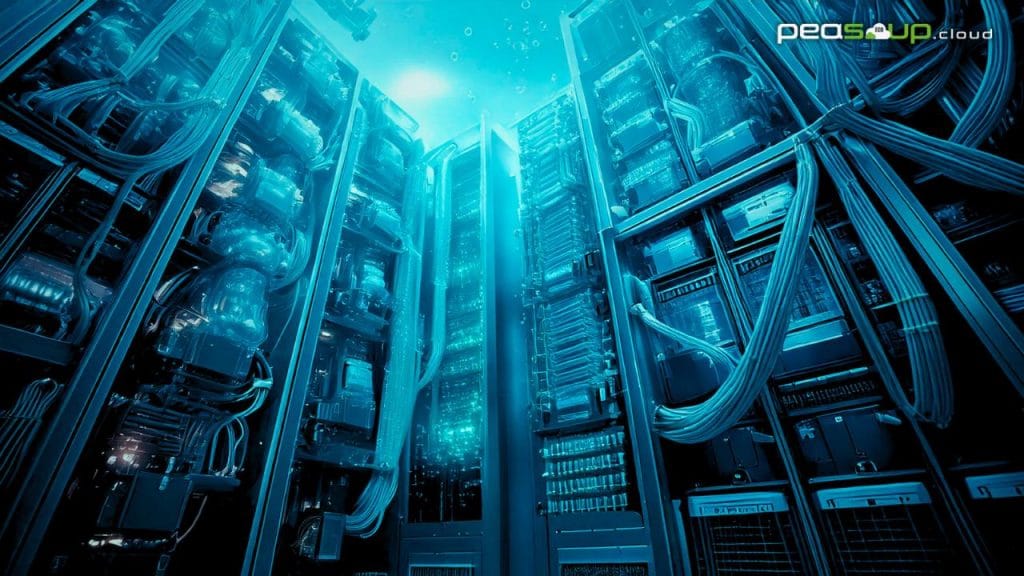Why Liquid Cooling is the Key for AI Data Centres
Liquid cooling is a pivotal technology for sustainable AI data centres, addressing critical challenges such as energy efficiency, heat management, and environmental impact.
Here’s why:
Efficient Heat Dissipation
AI workloads generate immense heat due to the high-density processing demands of GPUs and TPUs. Liquid cooling is significantly more efficient at transferring heat compared to traditional air cooling—up to 1,000 times more effective. This efficiency reduces the strain on cooling systems and minimises energy consumption.
Key Advantage
Liquid cooling is far superior to air cooling in heat removal due to the higher thermal conductivity of liquids.
- How it works: In liquid immersion cooling, servers are submerged in a thermally conductive, non-conductive fluid that absorbs heat directly from components like CPUs, GPUs, TPUs, network cards, etc. Heat is transferred away more effectively compared to traditional air-cooling systems that rely on fans and air circulation.
- Efficiency Comparison: Liquid can absorb 1000 times more heat than air per unit volume. This makes it possible to maintain stable temperatures even for the most heat-intensive AI hardware.
- Impact on Performance: By keeping hardware at optimal temperatures, liquid cooling prevents performance throttling due to overheating, enabling AI models to run continuously at full capacity! (important)
Reduced Power Usage Effectiveness (PUE)
Liquid cooling directly impacts a data centre’s PUE by reducing the energy required for cooling infrastructure. AI-focused data centres often achieve PUE values as low as 1.03 with liquid immersion cooling, compared to 1.5 or higher with air cooling.
Key Metric: PUE = Total Energy Used by the Data Centre / Energy Used by IT Equipment.
- Reduction in Cooling Overhead: Traditional air-cooling systems consume a huge amount of energy for fans, air handling units, and chillers. Liquid cooling eliminates or drastically reduces these requirements.
- Real Example: With liquid cooling, PUE values can drop as low as 1.03–1.1, meaning only 3–10% of the energy is used for non-IT operations like cooling. In contrast, air-cooled data centres often have PUE values around 1.5 or higher, with a much larger share of energy spent on cooling.
- Sustainability Impact: Lower PUE directly translates to reduced operational costs and a smaller carbon footprint. This efficiency is crucial for AI workloads, where energy demands are exponentially higher than traditional workloads.
Support for High-Density Deployments
AI workloads demand high-density server configurations. Traditional cooling struggles to handle these densities without compromising performance. Liquid cooling enables compact server layouts while maintaining optimal operating temperatures, maximising resource utilisation.
AI workloads rely on high-performance hardware like GPUs and TPUs, which generate substantial heat. Packing these components tightly together in traditional air-cooled racks is almost impossible and would lead to hotspots and inefficiencies.
- Liquid immersion cooling enables 10x greater server density because it removes heat at the source. Components can be arranged more compactly without compromising thermal management.
- AI and machine learning applications often require racks exceeding 30 kW per rack, which would be difficult or impossible to cool effectively with air. Liquid cooling can handle racks up to 100–200+ kW, meeting the needs of advanced AI models and hyperscale deployments.
Lower Carbon Footprint
By improving cooling efficiency, liquid cooling reduces the overall energy demand of data centres. When paired with renewable energy sources, this significantly lowers carbon emissions, supporting net-zero goals.
Increased Equipment Longevity
Liquid immersion cooling minimises thermal and mechanical stress on components, leading to longer hardware lifespans. For AI data centres, this means reduced waste and lower costs for hardware replacement, further contributing to sustainability.
Unlike traditional cooling methods, liquid immersion cooling recirculates coolant, minimising water consumption – a critical factor for eco-conscious AI operations.
Future-Proofing AI Data Centres
As AI workloads grow in complexity and scale, liquid cooling provides the scalability and efficiency necessary to meet evolving demands sustainably.
Summary
By integrating liquid cooling, AI data centres can not only enhance performance but also align with global sustainability targets, offering a path to greener, smarter computing.

